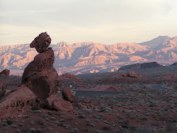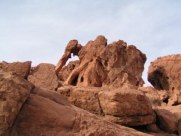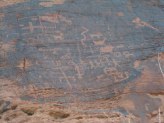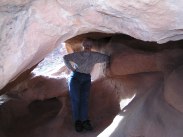Valley of Fire Travel Adventures at a Spectacular Nevada State Park
Our guest post comes from Bonnie & Bill Neely of: Real Travel Adventures Ezine – Your free online monthly travel magazine with hundreds of features and photos on travel to anywhere.

Between Las Vegas and the Northern shore of Lake Mead stretches a most spectacular and awe-inspiring expanse of rugged gray sandstone mountains and rich red, carved rock mounds, which form a popular hiking and picnicking State Park called the Valley of Fire, which attracts about 200,000 visitors a year.
This was created as the first of Nevada’s State Parks and 8,760 acres were dedicated in 1934. The tallest mountains of the range are the oldest, and in Paleolithic times, before the dinosaurs, these peaks were the bottom of an ancient sea, now long gone. Shells and fossils reveal their story to geologists. The shorter and more prominently-fascinating red columns and huge rock piles are younger, from the Mesozoic Period when dinosaurs roamed. These intriguing wind-carved columns and balancing rock boulders have funny faces and weird shapes.

In this, one of the hottest and driest areas of the United States, the fascinating and grotesque, sometimes frightening shapes and holes were not sculpted by rain but by fierce winds, which swept across the land. To the casual tourist much of this desert landscape seems bleak and uninteresting, with gray, rocky soil dotted with desert scrub plants, tumbleweed, and creosote bush. The main fascination, and the reason to bring plenty of film, is the incredible array of natural colors in the rock formations, especially on the 11-mile Rainbow Vista drive to the Domes area. You can drive or walk in this beautiful expanse where you see 150 million years of geology in the colored rock formations.
Nature has used her most prolific palette to paint the vast rocky mounds in exquisite, often iridescent, pastel colors from yellow to pink. The intense desert sun plays across this canvas, constantly changing the colors like a Technicolor dream. Each sunrise, or sunset behind the dark gray mountains is absolutely breathtaking.
More serious-minded travelers, who like to learn about the places they experience in order to appreciate their surroundings with more understanding, will want to stop at the excellent Visitor Center to learn about the area’s geological history, the flora and fauna, and the civilizations which lived here. Life in the desert is harsh and only the skilled and hardy can survive. Among those who mastered life here were the ancient Gypsum People (4,000 to 1,800 years ago,) who hunted big horned sheep and lived in caves where scientists have found straw animals they fashioned.

The next civilization (2,000 to 1,450 years ago) were Basket Weavers and planters, while still hunting and gathering. They lived in caves and earthen pits houses. Coil baskets and woven sandal prints have been found from this period. After these came the Anasazi/Pueblo People (1,500 – 850 years ago) who learned how to make more sophisticated weapons by sharpening rocks to make arrowheads for hunting. These Indians planted and harvested crops and made beautiful pottery, decorated with white and black slip. They traded with other groups from the California coast. These people were the forerunners to the Southern Paiute Native Americans who lived in this area successfully from 900 years ago to the present. In early years they adapted well to the dry climate, making rabbit skin blankets and expert baskets in which they learned to place water and hot rocks to cook grains and make mush.
In the 1500’s the Spanish conquerors and padres came to occupy forcefully and killed many of the native people. Then two centuries of Mormons, trappers, traders, American soldiers, gold-rushers, and pioneers trudged through. The railroad was the determining force to create towns, and in 1905 Las Vegas was established as a railroad construction town. In 1916 the first all-weather road in America was built by volunteers along the route from Los Angeles to St. Thomas. Called the Arrowhead Trail, this packed dirt roadway for cars was considered both dangerous and thrilling and was made famous by Thomas Bigelow, a reporter who traversed it several times in his “Cactus Kate” Packard automobile. You can see parts of this historic trek still preserved, with its rock pile reinforcements through dips and crags.
Desert life is harsh and difficult for animals, and every creature is interdependent on each of the others, down to the smallest insect. Among those who have been able to adapt for survival are the desert fox, tarantulas, kangaroo rats, coyote, black-tailed jackrabbit, burrowing owls, many lizards and geckos, bobcats, chuckwallas, the desert tortoise, and others. Only modern man can mess up the delicate web of life which struggles so admirably for survival, finding water in seeds or holes in the rocks, as did the famous Paiute named “Mouse,” who terrorized both Indian and white man in the late 1800’s and hid out for six months near Mouse Tanks, where animals and Indians knew they could find fresh water. Today you can hike to this interesting place, past hundreds of fascinating petroglyphs, carved into the desert varnish which stains the red rock cliffs. These ancient drawings show children, adults, sheep, snakes, and many symbols which may, or may not, be accurately deciphered by today’s archeologists.

Don’t cheat yourself by just driving through this amazing desert/mountain landscape. Get out of your car and take a hike. Be sure to take water and sun protection for skin and eyes. You are in a desert!
There are many marked trails to interesting places, and these hikes are under a mile and a half. When you walk amidst the giant, red sculptures your imagination will see monsters, elephants, fish, dinosaurs, lizards, skeletons, and skulls. It’s fun to decide what Nature’s Sculptor is whimsically depicting. The wonderful “hidey holes” are fun to crawl into to take photos, or to throw down a sleeping bag and curl up for a marvelous night beneath billions of stars winking at you through the crisp and chilly desert night air. You’ll see the Milky Way clearly and more stars than you ever knew existed.




